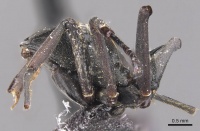Polyrhachis alluaudi
| Polyrhachis alluaudi | |
|---|---|

| |
| Scientific classification | |
| Kingdom: | Animalia |
| Phylum: | Arthropoda |
| Class: | Insecta |
| Order: | Hymenoptera |
| Family: | Formicidae |
| Subfamily: | Formicinae |
| Tribe: | Camponotini |
| Genus: | Polyrhachis |
| Subgenus: | Myrma |
| Species group: | militaris |
| Species: | P. alluaudi |
| Binomial name | |
| Polyrhachis alluaudi Emery, 1892 | |
| Synonyms | |
| |
The nest of the species was described and figured in the original description and was reproduced by Wheeler (1922a:267, fig. 74). Emery stated that the nest was constructed of rather coarse vegetable fibres loosely glued together and attached to the underside of a leaf about 1·7 m above the ground. The nest appeared as a low-vaulted chamber with the entrance situated at the apex of a funnel-like extrusion arising from near the centre of the nest.
Identification
A member of the Polyrhachis militaris species-group. Bolton (1973) - Appears to be closest related to Polyrhachis rufipalpis, from which it differs in size (larger) and in possessing distinct, scattered punctures on the sides of the head. These punctures may occur singly but are usually in closely approximated groups of three or four.
Keys including this Species
- Key to Afrotropical Polyrhachis species (Bolton 1973, OUTDATED)
- Key to Afrotropical Polyrhachis species
Distribution
Latitudinal Distribution Pattern
Latitudinal Range: 0.516667° to 0.516667°.
| North Temperate |
North Subtropical |
Tropical | South Subtropical |
South Temperate |
- Source: AntMaps
Distribution based on Regional Taxon Lists
Afrotropical Region: Democratic Republic of Congo, Ivory Coast (type locality).
Distribution based on AntMaps
Distribution based on AntWeb specimens
Check data from AntWeb
Countries Occupied
| Number of countries occupied by this species based on AntWiki Regional Taxon Lists. In general, fewer countries occupied indicates a narrower range, while more countries indicates a more widespread species. |

|
Estimated Abundance
| Relative abundance based on number of AntMaps records per species (this species within the purple bar). Fewer records (to the left) indicates a less abundant/encountered species while more records (to the right) indicates more abundant/encountered species. |

|
Biology
Wheeler (1922a:266) states that a single worker of this species was found in the stomach of a frog.
Castes
Nomenclature
The following information is derived from Barry Bolton's Online Catalogue of the Ants of the World.
- alluaudi. Polyrhachis alluaudi Emery, 1892d: 567, pl. 15, figs. 9, 10 (w.) IVORY COAST. Bolton, 1973b: 297 (q.). Combination in P. (Myrma): Forel, 1916: 448. Senior synonym of anteplana: Bolton, 1973b: 297.
- anteplana. Polyrhachis (Myrma) alluaudi var. anteplana Forel, 1916: 448 (w.) DEMOCRATIC REPUBLIC OF CONGO. Junior synonym of alluaudi: Bolton, 1973b: 297.
Unless otherwise noted the text for the remainder of this section is reported from the publication that includes the original description.
Description
Worker
Bolton (1973) - TL 6.7-7.1, HL 1.67-1.78, HW 1.26-1.37, CI 75-77, SL 1.81-2.03, SI 143-148, PW 1.15-2.03, MTL 1.92-2.08. (4 measured.)
Anterior clypeal margin convex, arcuate, entire except for a few median notches marking the sites of insertion of the marginal clypeal hairs. In profile the clypeal outline sinuate, broadly and shallowly S-shaped. Eyes convex, the sides of the head in front of the eyes elongate, straight to weakly concave and somewhat convergent anteriorly. Alitrunk marginate throughout its length, interrupted at the sutures. Pronotum flat to shallowly transversely concave, armed with a pair of short spines. Mesonotum flat to shallowly concave. Propodeum armed with a pair of upcurved teeth, the dorsal surface concave, especially behind the metanotal groove. Sutures well developed on dorsum of alitrunk; the promesonotal incised, the metanotal groove deeply impressed. Petiole with four spines, the dorsal notably longer than the lateral pair.
Erect hairs present only on the anterior clypeal margin and the gastral apex. An extremely sparse and fine pubescence present, most easily seen on the sides of the alitrunk.
Sculpture everywhere of a fine, dense reticulate-puncturation, the sides of the head, especially below and in front of the eyes with numerous coarser punctures.
Queen
Bolton (1973) - As worker, with the usual differences associated with the caste.
Type Material
Bolton (1973) - Holotype worker, IVORY COAST: Assinie (Ch. Alluaud) (Museo Civico di Storia Naturale, Genoa) [examined].
References
- Bolton, B. 1973b. The ant genus Polyrhachis F. Smith in the Ethiopian region (Hymenoptera: Formicidae). Bulletin of the British Museum (Natural History) Entomology. 28:283-369. (page 297, queen described, Senior synonym of anteplana)
- Emery, C. 1892f [1891]. Voyage de M. Ch. Alluaud dans le territoire d'Assinie (Afrique occidentale) en juillet et août 1886. Formicides. Ann. Soc. Entomol. Fr. 60: 553-574 (page 567, pl. 15 figs. 9, 10 worker described)
- Forel, A. 1916. Fourmis du Congo et d'autres provenances récoltées par MM. Hermann Kohl, Luja, Mayné, etc. Rev. Suisse Zool. 24: 397-460 (page 448, Combination in P. (Myrma))
- Rigato, F. 2016. The ant genus Polyrhachis F. Smith in sub-Saharan Africa, with descriptions of ten new species. (Hymenoptera: Formicidae). Zootaxa 4088:1–50.
References based on Global Ant Biodiversity Informatics
- Bolton B. 1973. The ant genus Polyrhachis F. Smith in the Ethiopian region (Hymenoptera: Formicidae). Bulletin of the British Museum (Natural History). Entomology 28: 283-369.
- Emery C. 1892. Voyage de M. Ch. Alluaud dans le territoire d'Assinie (Afrique occidentale) en juillet et août 1886. Formicides. Annales de la Société Entomologique de France 60: 553-574.
- Robson Simon Database Polyrhachis -05 Sept 2014
- Wheeler W. M. 1922. Ants of the American Museum Congo expedition. A contribution to the myrmecology of Africa. II. The ants collected by the American Museum Congo Expedition. Bulletin of the American Museum of Natural History 45: 39-269.
- Wheeler W. M. 1922. Ants of the American Museum Congo expedition. A contribution to the myrmecology of Africa. VIII. A synonymic list of the ants of the Ethiopian region. Bulletin of the American Museum of Natural History 45: 711-1004

